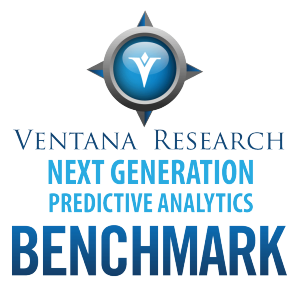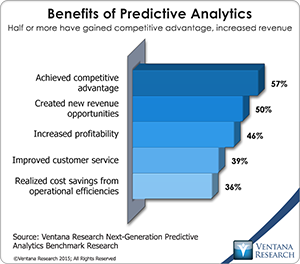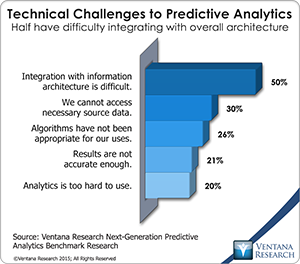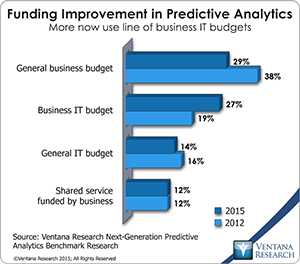Our recently released benchmark research into next-generation predictive analytics shows that in this increasingly important area many organizations are moving forward in the dimensions of information and technology, but most are challenged to find people with the right skills and to align organizational processes to derive business value from predictive analytics.
processes to derive business value from predictive analytics.
For those that have done so, the rewards can be significant. One-third of organizations participating in the research said that using predictive analytics leads to transformational change – that is, it enables them to do things they couldn’t do before – and at least half said that it provides competitive advantage or creates new revenue opportunities. Reflecting the  momentum behind predictive analytics today, virtually all participants (98%) that have engaged in predictive analytics said that they will be rolling out more of it.
momentum behind predictive analytics today, virtually all participants (98%) that have engaged in predictive analytics said that they will be rolling out more of it.
Our research shows that predictive analytics is being used most often in the front offices of organizations, specifically in marketing (48%), operations (44%) and IT (40%). While operations and IT are not often considered front-office functions, we find that they are using predictive analytics in service to customers. For instance, the ability to manage and impact the customer experience by applying analytics to big data is an increasingly important approach that I recently wrote about . As conventional channels of communication give way to digital channels, the use of predictive analytics in operations and IT becomes more valuable for marketing and customer service.
However, the most widespread barrier to making changes in predictive analytics is lack of resources (cited by 52% of organizations), which includes finding the necessary skills to design and deploy programs. The research shows that currently consultants and data scientists are those most often needed. Half the time those designing the system are also the end users of it, which indicates that using predictive analytics still requires advanced skills. Lack of awareness (cited by 48%) is the second-most common barrier; many organizations fail to understand the  value of predictive analytics in their business. Some of the reluctance to implement predictive analytics may be because doing so can require significant change. Predictive analytics often represents a new way of thinking and can necessitate revamping of key organizational processes.
value of predictive analytics in their business. Some of the reluctance to implement predictive analytics may be because doing so can require significant change. Predictive analytics often represents a new way of thinking and can necessitate revamping of key organizational processes.
From a technical perspective, the most common deployment challenge is difficulty in integrating predictive analytics into the information architecture, an issue cited by half of participants. This is not surprising given the diversity of tools and databases involved in big data. Problems with accessing source data (30%), inappropriate algorithms (26%) and inaccurate results (21%) also impede use. Accessing and normalizing data sources is a significant issue as many different types of data must be incorporated to use predictive analytics optimally. Blending this data and turning it into a clean analytic data set often takes significant effort. Confirming this is the finding that data preparation is the most challenging part of the analytic process for half of the organizations in the research.
Regarding interaction with other established systems, business intelligence is most often the integration point (for 56% of companies). However, it also is increasingly embedded in databases and middleware. The ability to perform modeling in databases is important since it enables analysts to work with large data sets and do more timely model updates and scoring. Embedding into middleware has grown fourfold since our previous research on predictive analytics in 2012; this has implications for the emerging Internet of Things (IoT), through which people will interact with an increasing array of devices.
Another sign of the broader adoption of predictive analytics is how and where buying decisions are made. Budgets for  predictive analytics are shifting. Since the previous research, funding sourced from general business budgets has declined 9 percent and increased 8 percent in line-of-business IT budgets. This comports with a shift in the form in which organizations prefer to buy predictive analytics, which now is less as a stand-alone product and more embedded in other systems. Usability and functionality are still the top buying criteria, reflecting needs to simplify predictive analytics tools and address the skills gap while still being able to access a range of capabilities.
predictive analytics are shifting. Since the previous research, funding sourced from general business budgets has declined 9 percent and increased 8 percent in line-of-business IT budgets. This comports with a shift in the form in which organizations prefer to buy predictive analytics, which now is less as a stand-alone product and more embedded in other systems. Usability and functionality are still the top buying criteria, reflecting needs to simplify predictive analytics tools and address the skills gap while still being able to access a range of capabilities.
Overall the research shows that the application of predictive analytics to business processes sets high-performing organizations apart from others. Companies more often achieve competitive advantage with predictive analytics when they support the deployment of predictive analytics in business processes (66% vs. 57% overall), use business intelligence and data warehouse teams to design and deploy predictive analytics (71% vs. 58%) and fund predictive analytics as a shared service (73% vs. 58%). Similarly, those that train employees in the application of predictive analytics to business problems achieve more satisfaction and better outcomes.
Organizations looking to improve their business through predictive analytics should examine what others are doing. Since the time of our previous research, innovation has expanded and there are more peer organizations across industries and business functions that can be emulated. And the search for such innovation need not be limited to within one’s industry; cross-industry examples also can be enlightening. More concretely, the research finds that people and processes are where organizations can improve most in predictive analytics. We advise them to concentrate on streamlining processes, acquiring necessary skills and supporting both with technology available in the market. To begin, develop a practical predictive analytics strategy and enlist all stakeholders in the organization to support initiatives.
Regards,
Tony Cosentino
VP and Research Director

 processes to derive business value from predictive analytics.
processes to derive business value from predictive analytics.










